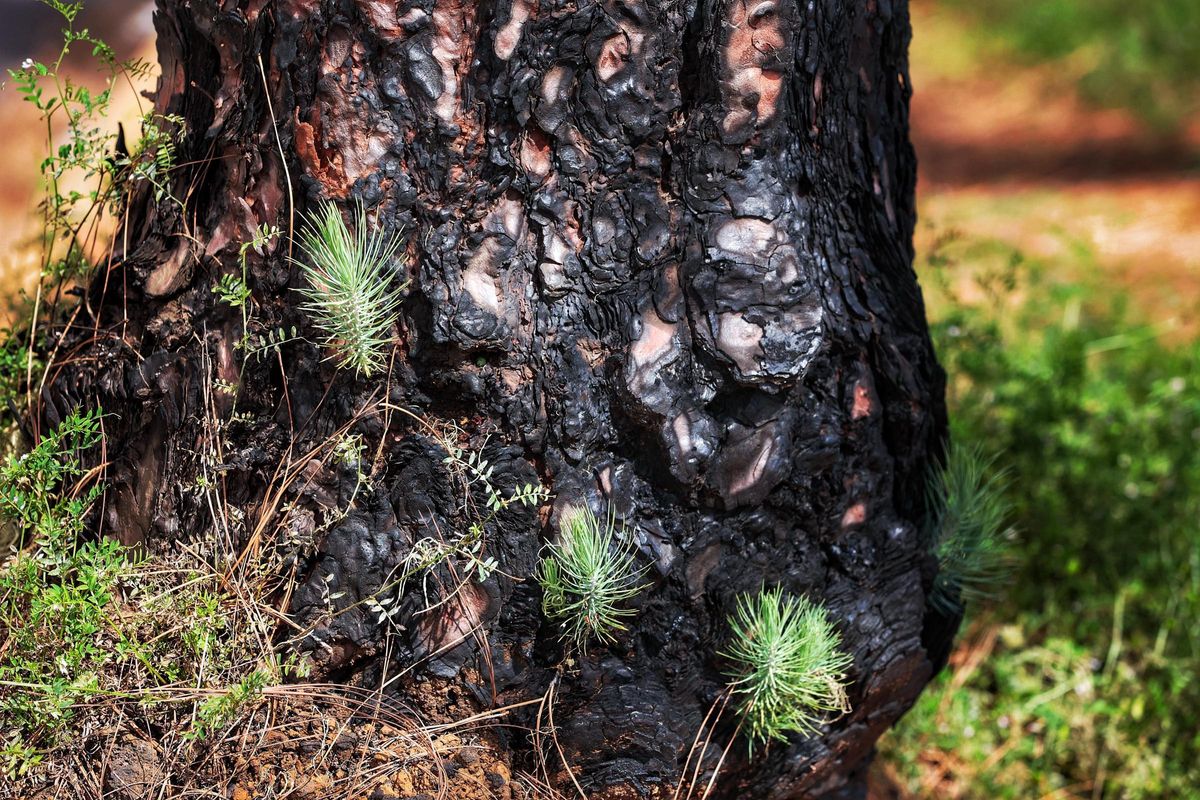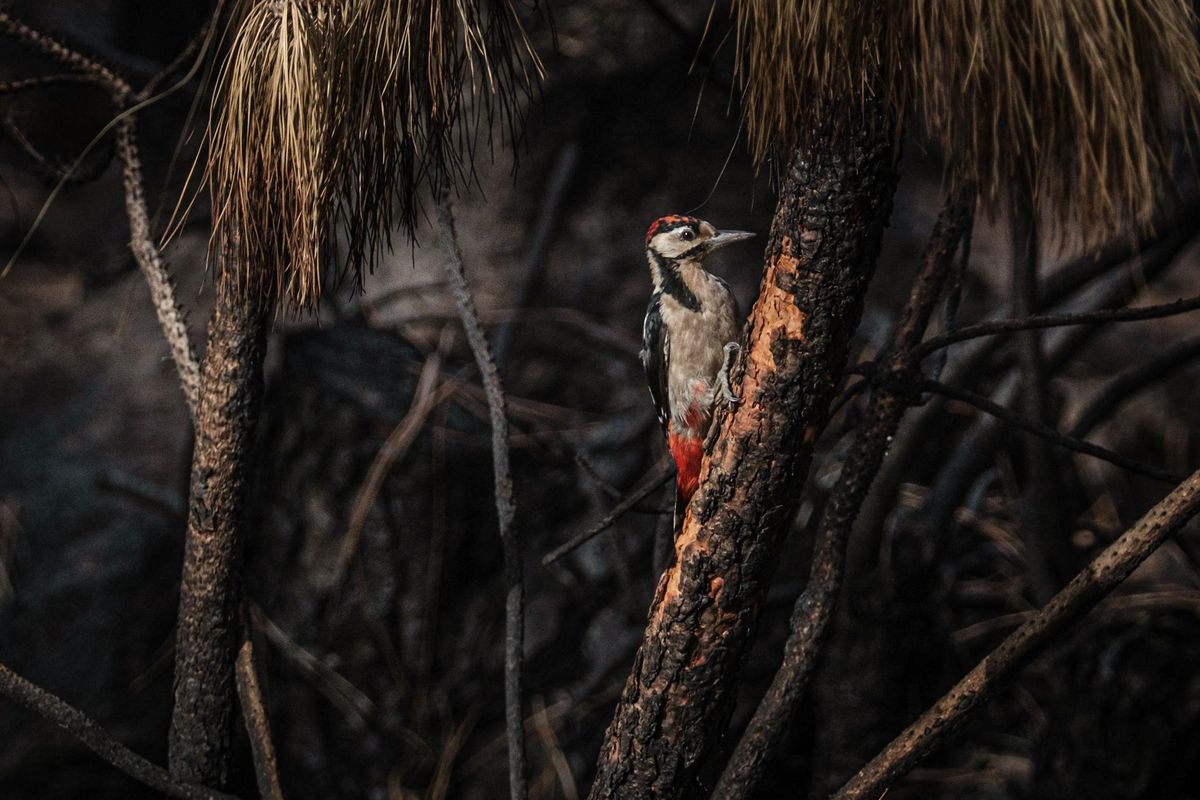What doesn’t kill you makes you stronger. This phrase has never been more accurate for one of the most peculiar species of native flora: the Canary Island pine tree. Thriving in an Archipelago with volcanic activity has led this species to be a “tremendously special tree in the world,” according to Manuel Nogales, Ph.D. in Biological Sciences from the University of La Laguna (ULL) specializing in Zoology and Botany. The Canary Island pine tree has a high resistance to fire. Its bark, up to eight centimeters thick, acts as a natural insulator against flames and high temperatures that are increasingly common.
This resilience explains why just seven months after one of the worst fires in Tenerife’s history, green shoots are beginning to proliferate on the charred trunks of the species that bore the brunt of the flames. The fire that broke out last August in the highlands of Arafo ravaged the Tenerife forest, precisely the protected area that encompasses the best pine forests on the island.
As seen now, it is capable of regrowth from stumps. This has earned it the reputation of the phoenix tree that rises from the ashes. Also noteworthy is its unique seed bank, called serotinous pine cones. These are located at a great height and protected by their proximity to the tree trunk. When exposed to high temperatures, they open up and release their seeds. All these factors make it the most resistant pine tree in the world to these natural disasters.

Buds at the base of a pine tree on Mount La Esperanza. / María Pisaca
60% of the forested area in the Islands, around 120,000 hectares, is populated by this species. Pine forests are essential for the conservation of Tenerife’s ecosystem. They help in oxygen production and air purification, serve as a refuge for flora and fauna while condensing water from the clouds and retaining it in the soil under the layer of dry pine needles they shed.
13 Million Years Ago
[–>
Originating from the Mediterranean, the species was established practically at the origins of the Islands 13 million years ago to become the most emblematic tree of the Archipelago, along with the dragon tree. Through a long evolution, those original pines acquired peculiarities in their adaptation to the islands. They have endured many eruptions and fires. Now it’s the turn of last summer’s fire, which affected over 12,000 hectares of forest land.
The green shoots are starting to become the protagonists in a landscape still stained with a dark soot. Their characteristic pine needles seem to emerge from between pieces of charcoal on a trunk that bears witness to the violent action of the fire. Despite the hope brought by this greenery to the pine forest, specialists maintain their distance from opinions that are deemed “overly positive” regarding the possibility of having a healthy pine forest again.
The strength of this tree against fire is due to its development in a volcanic territory
[–>
Typically, pine forests take about 10 years to recover. This time, it is uncertain how long the process will take. “It will depend on how the following years unfold in terms of precipitation and temperatures,” explains Manuel Nogales. The drought suffocating the Archipelago, which led the Tenerife Council to declare a water emergency, and the extreme heat prompted the Canary Islands Government to activate the fire prevention plan earlier than usual on Monday, 18th, following a winter that the State Meteorological Agency describes as the hottest and driest on record. In this summery winter, the average temperature was 2.5 degrees higher for this time of year, and rainfall was very scarce. “In a context of rampant climate change over the past 20 years, this species seems to be reaching its limit,” emphasizes Nogales, warning that “many pines may not survive.”
Roberto Castro is a forest engineer and one of the founders of Phoenix Canarias, a non-profit organization that seeks to educate society about forest management and the great value of forest ecosystems in the Canary Islands. He asserts that one should not be “overly optimistic” about the pine tree’s recovery after the summer fire. He also criticizes the global environmental situation and believes that having a healthy pine forest again is “something that is not always certain.” The recurrence of fires and global warming “make this process increasingly difficult.” “No matter how well-prepared it is to withstand fire, it can still die. In fact, many pines have perished in fires like the one in Gran Canaria in 2019,” he explains.
The intensity of the flames ravaged the pine forest of the Corona Forestal with a density reaching up to 3,000 exemplary pines per hectare. This “hyperdensity,” as Castro affirms,I assumed that “there were weak pines that had not been able to grow vigorously and whose recovery will be slower”.
[–>
Experts clarify that not all Canarian pines will heal the wounds of last summer’s fire
[–>
In ancient times, fires occurred due to natural causes. José Ramón Arévalo, professor of Ecology at the University of La Laguna, explains how fires could be caused by the fall of rocks which, upon impact, could ignite combustion. Now it is unlikely for this to happen, with the main cause of modern fires being human activity. The increase in urbanization and a higher number of inhabitants on the edges and areas of pine forests exposes these trees to a situation of “greater vulnerability”.
Another important factor is that more and more people go to the mountains to engage in recreational activities. Especially after the pandemic, there has been an increased interest in connecting with nature. This boom raises the risk of accidents that could trigger forest fires due to reckless or accidental activities. These include harmful practices such as waste accumulation or the threat of cigarette butts being thrown from vehicles. Manuel Nogales, who holds a PhD from the ULL and works for the Higher Council for Scientific Research (CSIC), attributes these issues to the overcrowding of the Island: “With two million inhabitants, the chances of having arsonists among us are higher”.
In the time when there was no human presence on the Island, fires would extinguish themselves once the forest burned completely. Now, with the fragmentation of the pine forest due to road construction, in addition to the natural separation within the forest, fires do not spread as they used to. Firefighting teams are also crucial, becoming increasingly prepared to carry out effective and swift firefighting operations. The doctor assures that the Canary Islands have “very well-prepared teams”.

The woodpeckers return to the pine forests of the Forest Crown. / Andrés Gutiérrez
Regarding solutions to these disasters, human intervention is essential. Nogales highlights “the lack of forest guards” as one of the main issues for prevention. The scientist points out that placing surveillance personnel at key access points during certain night hours and in the summer months, when conditions favour fire spread, is “an initiative that could prevent fires”. “In other words, make it as hard as possible for arsonists,” he emphasizes.
Nogales applauds the measures taken by the Tenerife Island Council with the investment in carrying out forestry practices. This involves allocating resources for the training and cultivation of forests, in this case, of the species found in the pine forest. “I think they are doing it very well because they have allocated a considerable amount of money and will continue to do so. It was necessary,” he adds. Among the initiatives, the Tenerife Island Council and the Foresta Foundation promote the restoration of forests through the Tenerife Renace project. The initiative has a donor fund of 170,000 Euros for the recovery of affected areas and a four-year execution period.
José Ramón Arévalo approaches fires, from an ecological perspective, as “a rebirth for the pine forest and a phenomenon that is part of the life cycle of this ecosystem”. “Its most predominant species and the one that gives the forest its name acquires greater resistance when subjected to these high-intensity fire episodes. Its endurance is due to coevolutionary processes. No species develops fire resistance without being subjected to them,” he emphasizes. In the eyes of ecology, the pine forest “is recovering”. Arévalo asserts that despite being far from that characteristic green and lush image of the pine forest, this forest “is already recovered and functioning”.
Fauna’s response
[–>
The fauna of the pine forest responds in the same way as the vegetation. It has also undergone evolutionary adaptation. Arévalo has conducted numerous studies on the consequences of fires. In 2009, he conducted a study on the blue chaffinch. This species exclusively inhabits the pine forests of Tenerife and Gran Canaria. It is an endemic species with two subspecies that are divided between Tenerife and Gran Canaria. In his research, he observed that the fire that occurred at that time expanded the distribution range of this species. Arévalo sees this as a positive outcome: “The population of this bird was found in places where it had not been seen before”.
Fires will continue to occur. This doctor states that ecology understands that there are dynamic processes in nature and for the phoenix tree, “this means exposing itself regularly to the natural disaster caused by flames”. “Therefore, the preparation of firefighting teams is essential”. According to the ecologist, the solution is to extend prevention periods and conduct studies to ensure the protection of the population.
[–>
For its recovery, Arévalo believes that “the mountain should be left alone”. Human presence can sometimes be detrimental. An example he gives is replanting that he does not believe is necessary in certain areas: “The pines, even if burnt, are alive”. Also, trusting in natural processes, José Ramón Arévalo emphasizes that human intervention for prevention “should only be done in specific areas where there are erosion problems”.















